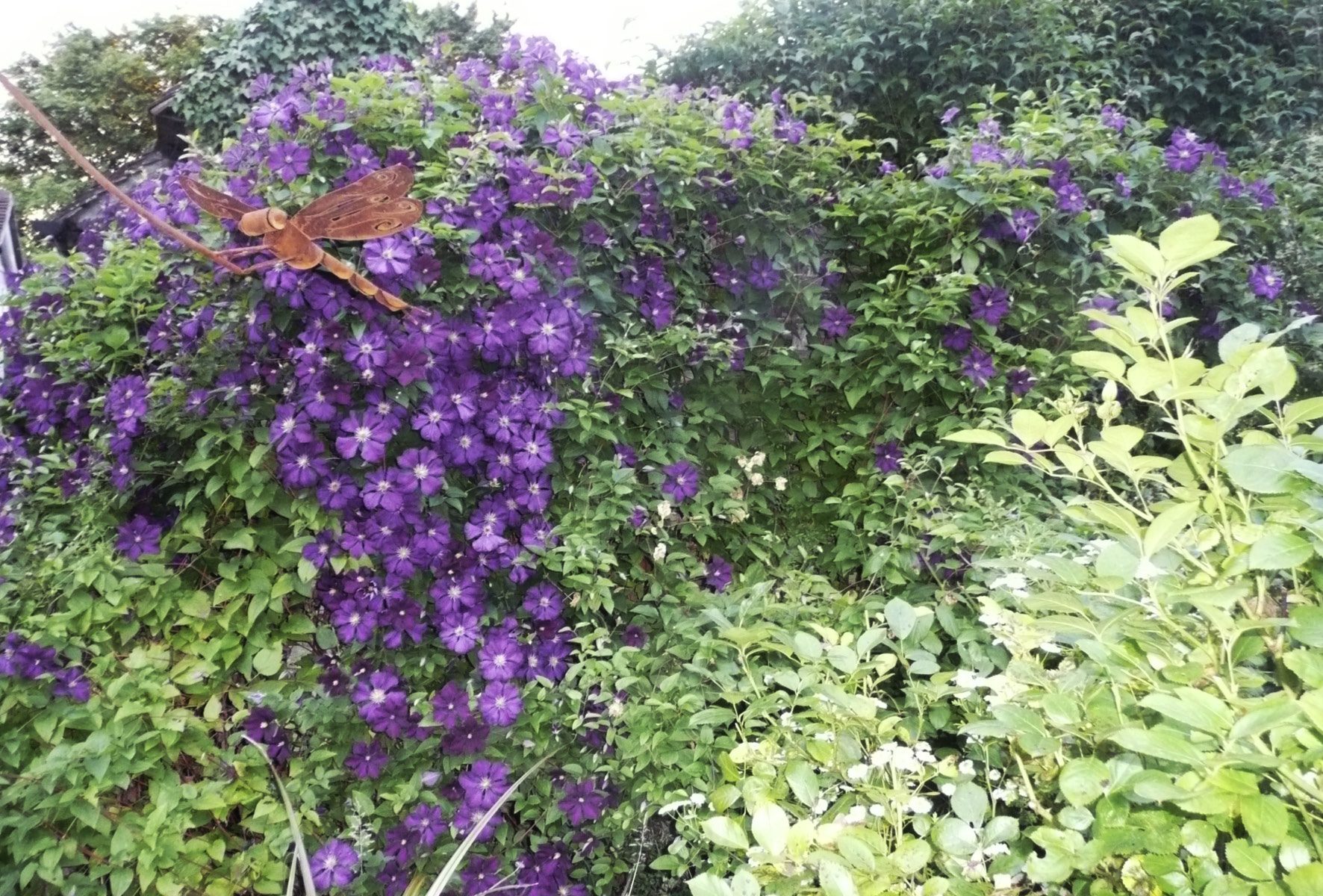I’m not sure that ‘instant’ and ‘climbers’ really go together but I thought I’d choose twelve plants that are both climbing, vigorous and good looking. Some of them are both decorative and edible and some have a glorious fragrance which is surely a bonus, both for us and the pollinating insects that home in on them. Some are perennial and some are annual treats but they are all fabulous; well, in my view anyway. So here goes…
Borlotti beans come in several different incarnations and the Italians use varying varieties in their regional dishes. They are a type of kidney bean with a ‘meaty chestnut’ flavour. What I like about them is that their pods are attractive, long and creamy flecked with red. They can be harvested when the pod gets a bit leathery and past its best. The beans can be frozen and used in the winter in stews and soups, dried or used fresh.
Clematis montana ‘Wilsonii’ was introduced by the plant finder, EH Wilson in the early twentieth century. It is different from the other montanas in that it flowers slightly later and has a delicious chocolaty scent. Like most of the montanas, it is vigorous and not too fussy about its aspect in the garden although I might avoid putting the plant in very deep shade. The flower is white, with a green tinge and the petals have a slight twist to them. This clematis is not often grown which is curious as it is a lovely thing.
Clematis ‘Etoile Violette’ I have had to add this to my list as it is such a reliable, easy to grow and floriferous plant. I cut mine down hard in the spring and up it comes covering a hazel panel or two in no time and completely obscuring a less than attractive oil tank. One of the viticella group, this clematis produces sheets of velvety, violet blue flowers. It would look good with golden foliage plants but do hesitate to actually grow it through a host tree or shrub as it will overwhelm it in no time at all.
Climbing French bean ‘Blauhilde’. Eat these fresh but not before you enjoy the really beautiful purple pods on this plant. Absolutely delicious, the beans turn green when they are cooked. The plant is vigorous; the pods can reach to up to a foot long and can be harvested from about July through into October. They have a good resistance to Bean Mosaic Virus. For sheer visual impact, try growing them near your borlotti beans.
The golden hop, Humulus lupulus ‘Aureus’, has hairy twining stems that will reach a height of twenty feet. The leaves are deeply lobed and the plant seems to grow before your eyes. It is herbaceous so will need to be cut right down but not before it produces its green fruits (hops) late in the season. It is happy in both sun or shade but I find that the leaves scorch a bit if conditions are too sunny and dry so it is ideal really for growing over a shed in a semi shaded position. Tie it in as it grows or as with a conventional hop grow it up twine which will give it plenty of support during the growing season.
Mina lobata or Ipomoea lobata. I love this plant and make a pilgrimage to the Cottage Garden at Sissinghurst to see it each year, usually in the late afternoon when with the sun behind it, you can see the flowers to their best effect. It looks really exotic which can put you off trying it, thinking that it will be difficult to get going. I think the trick is to sow the seed late, maybe May, so that it can take off immediately. It comes from Mexico and is covered in tubular flowers which are held in racemes on wiry stems branching out at right angles from the main stem. The colours vary from crimson/orange to creamy yellow as the flower matures. As the flowers develop individually you get lovely combinations of colour at any one time. It is a tender twiner, happy in sun or shade but doesn’t do well in rich or over fed soil.
Dolichos or Lablab. I can’t remember where I got seeds of this or where I first spotted it but the plant certainly stays in the memory. This is an edible bean, a variety of the Hyacinth Bean. D. ‘Ruby Moon’ is a cultivar with green and purple heart-shaped leaves, long bicoloured, pink and white flowers which stand out amongst the purple of the leaves followed by wide and rather flat rich dark purple seed pods. It is an annual and in the States is grown over pergolas like a vine. The beans look good in a vase.
Lathyrus grandiflorus. This is a perennial version of the annual sweet pea. It doesn’t have the fragrance of the annual but is very vigorous and has long-stemmed flowers. It comes in various shades of red, rosy pink and white. ‘White Pearl’ is a brilliant white version with good clusters of pearly flowers. It can either climb or if left untended, will sprawl. I think it’s a particularly good plant in that it has a long flowering season of about eight weeks with flowers that look great in a vase for some time.
Lathyrus odoratus ‘Cupani’. Another sweet pea but one of the earliest having been introduced by a Sicilian monk, Francis Cupani, in the 17th century. The flowers are simple compared to modern cultivars but the combination of maroon and mauve flowers and a strong, sweet fragrance make them a must for climbing up tripods and frames.
Lathyrus rotundifolius. There is a well established plant of this pea in the garden at Merriments, Hurst Green. The Persian everlasting pea – this one is happiest in a cool, shady and sheltered position. Easy to grow, with rather lovely terracotta red flowers and pretty rounded leaves. This is a gentle plant and it could be combined with roses. It has a long flowering season so would be ideal trained into a rose that perhaps doesn’t repeat flower.
Rhodochiton atrosanguineus. Purple bell vine. Another plant with heart-shaped green leaves, twining stems and lots of large single tubular maroon flowers with extremely decorative parasol-shaped rosy red calyces. Grow this one in a sheltered, sunny position and treat as a half-hardy annual.
Rubus phoenicolasius or Japanese wineberry. Related to the raspberry, this plant grows to about three metres tall. A perfect candidate for a winter garden, with arching stems protected by orange-red bristles. A biennial, like the raspberry, even the leaves are interesting as they are a bright green with white undersides. In summer you have star like white flowers in a bristly calyx which are followed in the autumn by beautiful (and delicious) orange red fruits. Plant in a sheltered spot and propagate by burying the tips of the canes during the growing season where they will soon take root. Cut out old stems that have fruited and tie in new stems as they appear. You can encourage branching by pinching out the canes in the spring.
- words: Sue Whigham
You may also like
Go with the Flow
Sue Whigham shares some valuable new-to-gardening advice I’m sure that by now we should be used to the rain but I’m not entirely sure that we are. We had a dry, sunny day the other day and how everybody’s mood...
Farm Fables
Jane Howard gets to the bottom of why so many ponds have disappeared across the High Weald I have a new passion, almost an obsession, it’s about ponds. And there’s a distinct possibility I might become a bit of a...
Hedge Issues
Sue Whigham takes a meander along nature’s verdant and vital corridors Recently the BBC’s Today programme carried a feature about England’s hedgerows which created a lot of interest among listeners. On the strength of that, Martha Kearney interviewed one of...

















